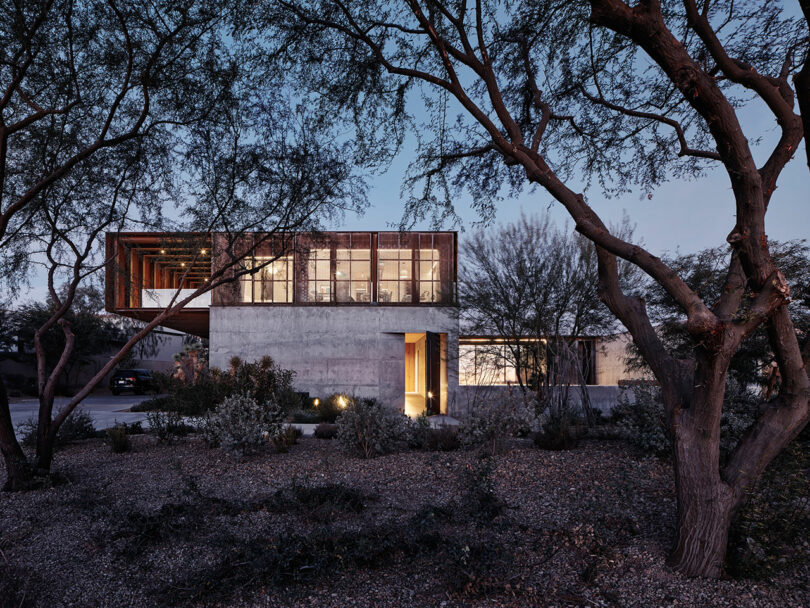The Red Rock House Is an Architectural Dialogue With the Desert
In the heart of Summerlin, Nevada, Faulkner Architects has designed the Red Rock residence in collaboration with Concept Lighting Lab as an extension of its natural environment. The home responds to the dramatic contrasts of its surroundings with views of the Las Vegas Strip to the east and the rugged Red Rock Canyon to the west. The scenic location, combined with the unforgiving climate of the Nevada desert, posed unique challenges and opportunities that shaped the design of the home. The result is a residence that reflects the desert’s stark beauty while offering refuge from its extreme conditions.
Situated on a three-quarter-acre lot, the house is designed to endure the punishing desert climate. The winds that sweep through the area are relentless, winters are cold and dry, and summers are blisteringly hot, punctuated by monsoon storms. These environmental factors necessitated a design approach that prioritizes protection from the elements while embracing the beauty of the landscape. At the same time, privacy and durability were key concerns, leading to a structure that is both robust and refined, minimalist yet deeply expressive.
The house embraces a minimalistic design philosophy that echoes the simplicity of the desert. The layout utilizes a subtractive approach, carving out a wind-sheltered courtyard on the eastern side of the property. Here, an elevated basin of water reflects the architecture, offering a mirror image of the living space and subtly referencing the distant skyline of Las Vegas. This integration of water contrasts with the arid desert, symbolizing the fragile relationship between nature and urban development.
The entryway to the home is designed to be an experience in itself. Visitors pass through a narrow opening in the massive concrete walls, which, at eye level with the basin, draws the eye to the reflection of the distant city. This threshold leads to a shaded and closed corridor that ramps up to a private entry courtyard. Open to the sky, this space is softened by a vertical garden of native desert plants, offering a serene transition from the outside world into the interior of the home. The architecture performs as a mediation between the rugged desert landscape and the more refined and controlled environment of the house.
The material palette of the Red Rock House is intentionally restrained, relying on local materials that connect the building to its surroundings. The use of locally sourced sand, gravel, and fly ash to create concrete for the floors and walls gives the structure a natural buff hue that resonates with the distant mountains. These materials were chosen not just for their aesthetic qualities but also for their ability to endure the desert conditions. In the intense desert light, the concrete takes on a warm, sunlit tone that changes throughout the day.
The upper-level sleeping areas are housed within a framework of perforated weathering steel. This screen not only protects the interior from the sun but also provides a measure of privacy while allowing for natural ventilation. The perforations in the steel create a dappled effect of light and shadow, adding a dynamic quality to the interior spaces as the sun moves across the sky.
In a gesture that further integrates the house with its surroundings, over half of the built structure is located below ground level. This not only reduces the building’s visual impact on the site but also provides natural insulation from the extreme temperatures. Sunlight is introduced into these subterranean spaces through carefully placed openings, some of which are submerged below the water level of the basin, creating a dramatic interplay of light, shadow, and reflection throughout the day.
The house is equipped with a range of energy-efficient systems, including a 45-kilowatt photovoltaic array that powers the home, high-efficiency glazing to reduce heat gain, and mechanical and lighting systems designed to minimize energy use. The roof, which is highly reflective, helps to mitigate the intense desert heat, while the design of the building itself maximizes natural ventilation and shading.
On the south side of the house, a shaded deck extends out from the structure, offering a place to relax while being shielded from the intense heat of the desert sun. The deck, which is screened with perforated mesh, also serves to protect the house and the cars parked below from the elements. This thoughtful integration of shading devices and natural ventilation systems ensures that the house remains cool and comfortable even during the hottest days of summer.
For more information on Faulkner Architects, click here, and for more from Concept Lighting Lab, click here.
Photography by Joe Fletcher.
from Design MilkInterior Design Ideas for Your Modern Home | Design Milk https://ift.tt/zwKiaUR
via Design Milk























No comments